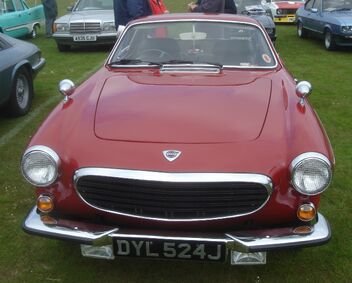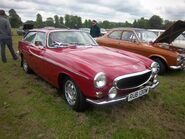
Volvo 1800E
The Volvo P1800 is a sports car from Volvo Cars.
History[]
The project was started in 1957 because Volvo wanted a sports car, despite the fact that their previous attempt, the P1900, had been a disaster, with only 68 cars sold. The man behind the project was an engineering consultant to Volvo, Helmer Petterson, who in the 1940s was responsible for the Volvo PV444. The design work was done by Helmer's son Pelle Petterson, who worked at Pietro Frua at that time. Volvo insisted it was an Italian design by Frua and only officially recognized that Pelle Petterson designed it in 2009. The Italian Carrozzeria Pietro Frua design firm (then a recently acquired subsidiary of Ghia) built from Sep 1957 to spring 1958 the first three prototypes, later designated by Volvo in September 1958 : P958-X1, P958-X2 and P958-X3, (P:Project 9:September 58:Year 1958 = P958)
In December 1957 Helmer Petterson drove X1, (the first hand-built P1800 prototype) to Osnabrück, West Germany, headquarters of Karmann. Petterson hoped that Karmann would be able to take on the tooling and building of the P1800. Karmann's engineers had already been preparing working drawings from the wooden styling buck at Frua. Petterson and Volvo chief engineer Thor Berthelius met there, tested the car and discussed the construction with Karmann. They were ready to build it and this meant that the first cars could hit the market as early as December 1958. But in February, Karmann's most important customer, Volkswagen VAG, forbade Karmann to take on the job.They feared that the P1800 would compete with the sales of their own cars, and threatened to cancel all their contracts with Karmann if they took on this car. This setback almost caused the project to be abandoned.
Other German firms, NSU, Drautz and Hanomag, were contacted but none was chosen because Volvo did not believe they met Volvo's manufacturing quality-control standards.
It began to appear that Volvo might never produce the P1800. This motivated Helmer Petterson to obtain financial backing from two financial firms with the intention of buying the components directly from Volvo and marketing the car himself. At this point Volvo had made no mention of the P1800 and the factory would not comment. Then a press release surfaced with a photo of the car, putting Volvo in a position where they had to acknowledge its existence. These events influenced the company to renew its efforts: the car was presented to the public for the first time at the Brussels Motor Show in January 1960 and Volvo turned to Jensen Motors, whose production lines were under-utilised, and they agreed a contract for 10,000 cars. The Linwood, Scotland, body plant of manufacturer Pressed Steel was in turn contracted by Jensen to create the unibody shell, which then taken by rail to be assembled at Jensen in West Bromwich, England. In September 1960, the first production P1800 (for the 1961 model year) left Jensen for an eager public.
P1800[]
The engine was the B18 (B for the Swedish word for gasoline: Bensin; 18 for 1800 cc displacement) with dual SU carburettors, producing 100 hp (75 kW). This variant (named B18B) had a higher compression ratio than the slightly less powerful twin-carb B18D used in the contemporary Amazon 122S, as well as a different camshaft. The 'new' B18 was actually developed from the existing B36 V8 engine used in Volvo trucks at the time. This cut production costs, as well as furnishing the P1800 with a strong engine boasting five main crankshaft bearings. The B18 was matched with the new and more robust M40 manual gearbox through 1963. From 1963 to 1972 the M41 gearbox with electrically actuated overdrive was a popular option. Two overdrive types were used, the D-Type through 1969, and the J-type through 1973. The J-type had a slightly shorter ratio of 0.797:1 as opposed to 0.756:1 for the D-type. The overdrive effectively gave the 1800 series a fifth gear, for improved fuel efficiency and decreased drivetrain wear. Cars without overdrive had a numerically lower-ratio differential, which had the interesting effect of giving them a somewhat higher top speed (just under 120 mph) than the more popular overdrive models. This was because the non-overdrive cars could reach the engine's redline in top gear, while the overdrive-equipped cars could not, giving them a top speed of roughly 110 mph (177 km/h).
1800S[]
As time progressed, Jensen had problems with quality control, so the contract was ended early at 6,000 cars. In 1963 production was moved to Volvo's Lundby Plant in Gothenburg and the car's name was changed to 1800S (the 'S' indicating Swedish assembly). The engine was improved with an additional 8 hp (6 kW). In 1966 the four-cylinder engine was updated to 115 hp (86 kW). Top speed was 175 km/h (109 mph). In 1969 the B18 engine was replaced with the 2-litre B20B variant of the B20 giving 118 bhp (89 kW), though it kept the designation 1800S.
1800E[]
For 1970 numerous changes came with the fuel-injected 1800E, which had the B20E engine with Bosch D-Jetronic fuel injection and a revised camshaft, and produced 130 bhp (97 kW) without sacrificing fuel economy. Top speed was around 190 km/h (120 mph) and acceleration from 0–100 km/h (0-62.1 mph) took 9.5 seconds. In addition, the 1970 model was the first 1800 with four-wheel disc brakes; till then the 1800 series had front discs and rear drums.
1800ES[]
In 1972 came the last model, the 1800ES, a coupé station wagon with an all-glass tailgate, sometimes described as a shooting-brake. The final design was chosen after two prototypes had been built by Sergio Coggiola and Pietro Frua. Frua's very unusual looking prototype, Raketen ("the Rocket", on the right), currently resides in the Volvo Museum. Both Italian prototypes were considered too futuristic, and instead in-house designer Jan Wilsgaard's proposal was accepted. The ES engine was downgraded to 125 bhp (92 kW) by reducing the compression ratio with a thicker head gasket (engine variant B20F); although maximum power was slightly down the engine was less "peaky" and the car's on-the-road performance was actually improved.
The ES's rear backrest folded down to create a long flat loading area. As an alternative to the usual four-speed plus overdrive manual transmission, a Borg-Warner three-speed automatic was available in the 1800ES.With stricter American safety and emissions standards looming for 1974, Volvo did not see fit to spend the considerable amount that would be necessary to redesign the small-volume 1800 ES. Only 8,077 examples of the ES were built in its two model years.
Influence[]
The all-glass tailgate of the ES-model would prove to be very popular with future Volvo-designers. A similar design was used on the Volvo 480, and on multiple concept cars. The Volvo C30 also uses this design.
End of the line[]
For the last model year, 1973, only the 1800ES was produced. Total production of the 1800 line from 1961 through 1973 was 47,492 units. Production ended on June 27, 1973, although Volvo was in negotiations with Coggiola concerning a possible P1800ESC. The cause of the P1800's demise was its competition: the Volvo P1800 was introduced at the same time as the Jaguar E-Type and in the US the P1800's price was not much less than the Jaguar. In fact, in the UK it was slightly more expensive than an E-Type.
While Volvo never produced a convertible version of the 1800, such cars were produced in the aftermarket.
The Saint's Volvo 1800[]
A white Volvo P1800 (with licence plate ST1) driven by Simon Templar, played by Roger Moore, was featured in the TV series The Saint beginning in 1962 and played a prominent role throughout the entire run of the show.
Two new cars were introduced at the Geneva Motor Show in 1961, a Jaguar E-type and the Volvo P1800. Jaguar was first offered the opportunity to provide an E-Type for the series but declined, feeling they had too much demand already and did not see the need for additional press. When asked for a P1800, Volvo jumped at the chance which led to an increase of sales of the P1800 and the creation of a 1960s' icon. Later, in the 1970s when The Return of the Saint was created, Jaguar made up for their mistake and offered the new XJ-S for the series.
Volvo lent two cars initially for the series - one for static studio shots and the other for moving shots. When the P1800S came along, one of the earlier cars was cut up to allow better interior shots.
Roger Moore was so smitten with the Volvo that he bought one for his own personal use.
Record-breaking 1800[]
A 1966 Volvo 1800S and its owner Irv Gordon of East Patchogue, New York, USA own the Guinness world record for highest mileage in the same vehicle he has been driving for more than 45 years. It had covered in excess of 2,219,751 miles (3,572,343 km) by March 2004, and passed the 2,600,000-mile (4,200,000 km) mark by October 2007. As of August, 2009, the car is at 2.7 million miles and the owner is now targeting the three million mile mark.
He has driven about 26,000 of those miles outside of the U.S., in Canada and Mexico, as well as in Europe. "In Sweden, we drove to Volvo's global headquarters to see where the P1800 was born", Gordon said.
On April 2, 2002, Gordon and his 1800S were guests on The Tonight Show with Jay Leno, after reaching the two million milestone.
As of July 2010, Gordon reached 2.8 million miles for his 70th birthday, and announced that he hopes to reach 3 million by the time he turns 73. That feat will require him to drive an average of around 5,500 miles per month.
Irv Gordon and his Volvo were featured on PBS's Nova science.
50th Anniversary[]
A major and much acclaimed 50th Anniversary of the P1800 took place in France on June 13, 2010 during the Viking Classic Auto Show, celebrating the first presentation of the P1800 to the public at the Brussels Motor Show in 1960. The show with more than 350 Volvo cars gathered the rarely seen number of 80 Volvo P1800 of all types and from all over Europe and the prototype P958-X1 in presence of yacht designer Pelle Petterson as well as Irv Gordon. The event was promoted with the support of Volvo Cars Heritage.









